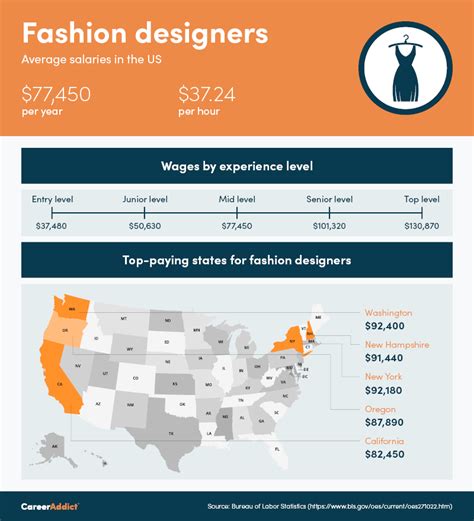Are you passionate about fashion and considering a career as a fashion designer? One of the most intriguing aspects of this creative industry is the potential for high-paying design careers. In this blog post, we will delve into the world of fashion designer salaries, uncovering key factors that influence earning potential and exploring various specializations and career paths within the field. From understanding the average fashion designer salary to dissecting regional variances and comparing compensation packages between corporate and independent designers, we will provide an in-depth look at the financial side of a fashion designer’s career. Whether you’re interested in pursuing celebrity design collaborations or negotiating for a higher paycheck, this post will equip you with the knowledge to make informed decisions and pave the way for a lucrative career in fashion design. So, if you’re ready to make a fashion statement with your earnings, read on to discover the exciting world of fashion designer salaries.
Table of Contents
Average Fashion Designer Salary: Understanding the Numbers
When considering a career in fashion design, one of the first questions that comes to mind is, What is the average fashion designer salary? Understanding the numbers behind fashion designer salaries is crucial for individuals passionate about pursuing a career in the industry. Factors such as education, experience, specialization, location, and industry all play a role in determining the average salary for fashion designers. By understanding these numbers, aspiring fashion designers can make informed decisions about their future career paths and earning potential.
One of the key factors influencing the average fashion designer salary is education and experience. Designers with a bachelor’s or master’s degree in fashion design typically earn higher salaries than those without formal education. Additionally, experience in the field can significantly impact earning potential. Entry-level designers may start with lower salaries, but as they gain more experience and develop a strong portfolio, they can command higher pay.
Another important consideration when it comes to understanding fashion designer salaries is specialization. Designers who specialize in niche areas such as haute couture, accessories, or sustainable fashion often have higher earning potential compared to those working in more general design roles. Specializing in a particular area can set fashion designers apart and lead to more lucrative opportunities.
Location is also a significant factor in determining the average fashion designer salary. Fashion capitals such as New York, Paris, and Milan typically offer higher salaries for designers, reflecting the higher cost of living in these cities and the concentration of fashion industry opportunities. Regional variances in salaries should be taken into account when considering where to build a career as a fashion designer.
Factors Influencing Fashion Designer Salaries: Beyond the Runway
When it comes to the fashion industry, there are many factors that can influence a designer’s salary, extending beyond the glamorous runway shows and high-profile collaborations. One of the most significant factors is experience. As with many careers, the more experience a fashion designer has, the higher their salary is likely to be. This is because experienced designers have a deeper understanding of the industry, a larger network, and a proven track record of successful designs.
Another crucial factor is education. Fashion designers who have pursued advanced degrees or specialized training in areas such as textile design, pattern-making, or fashion merchandising are often able to command higher salaries. This additional education not only provides designers with valuable skills and knowledge but also demonstrates a commitment to their craft, which can be attractive to potential employers.
Additionally, the location in which a fashion designer works can have a significant impact on their earning potential. For example, designers working in fashion hubs such as New York City, Los Angeles, or Paris may command higher salaries due to the competitive nature of these markets and the presence of major fashion brands and design houses.
Lastly, a designer’s specialization within the industry can also influence their salary. Specializing in a niche area such as haute couture, sustainable fashion, or costume design can open up unique opportunities for higher-paying roles and collaborations.
Education and Experience: Paving the Way to Lucrative Opportunities
One of the most influential factors in determining a fashion designer’s salary is their level of education and professional experience. Fashion designers with a strong educational background and years of experience in the industry often have access to more lucrative job opportunities.
Higher education in the form of a degree from a reputable fashion design program can open doors to higher-paying positions within the industry. Many employers prefer to hire designers who have completed a formal education in fashion design, as it demonstrates a certain level of commitment and skill. In addition, designers with a strong educational foundation often have a better understanding of design principles, technical skills, and industry trends, which can make them more valuable to potential employers.
Professional experience also plays a crucial role in determining a fashion designer’s earning potential. Designers who have spent years working in the industry, building up a portfolio of successful projects and collaborations, are often able to command higher salaries. Experience not only hones a designer’s skills and abilities, but also allows them to develop a network of industry contacts that can lead to more profitable opportunities.
In conclusion, education and experience are key factors in paving the way to lucrative opportunities for fashion designers. By obtaining a solid educational foundation and gaining valuable experience in the industry, designers can position themselves for higher-paying and more rewarding careers in the field of fashion design.
Fashion Design Specializations: Elevating Earnings Potential
When it comes to pursuing a career in fashion design, specialization can be the key to elevating earnings potential. Designers who focus their skills and expertise in specific areas of the fashion industry are often able to command higher salaries and access more lucrative opportunities.
One such specialization is in the realm of haute couture. Couture fashion designers, often working for prestigious fashion houses or operating their own ateliers, are renowned for creating custom, high-end garments for discerning clientele. This niche market commands premium prices, and as a result, couturiers have the potential to earn significantly more than their counterparts in mainstream fashion.
Another specialized area within fashion design that can lead to higher earnings is in the field of technical design. Technical designers are responsible for creating detailed garment specifications and patterns that are used in mass production. With a keen eye for precision and an understanding of manufacturing processes, technical designers play a crucial role in ensuring the quality and fit of garments, making them valuable assets to fashion companies and thus, able to negotiate for higher pay.
Furthermore, luxury fashion design is a highly sought-after specialization that can bring in substantial earnings. Designers who focus on creating high-end, luxury clothing, accessories, or footwear often have the opportunity to work with prestigious brands and cater to affluent clientele. This level of exclusivity and demand for premium craftsmanship commands a higher price point, allowing luxury fashion designers to command top salaries within the industry.
Location Matters: Exploring Regional Variances in Fashion Salaries
When it comes to fashion designer salaries, where you work can have a significant impact on how much you earn. In major fashion capitals like New York, Paris, and Milan, salaries tend to be higher due to the concentration of high-profile fashion houses and brands. The cost of living in these cities is also generally higher, which means employers need to offer more competitive salaries to attract and retain top talent.
On the other hand, fashion designers working in smaller or less well-known cities may not earn as much, despite potentially having a lower cost of living. This discrepancy in regional earnings can make a big difference in a fashion designer’s overall income and standard of living.
Furthermore, the availability of opportunities in different locations can also impact fashion designer salaries. For example, a designer working in a city with a robust fashion industry may have more opportunities for career advancement and professional development, which can lead to higher salaries in the long run.
It’s important for aspiring fashion designers to consider the location of their future careers and the economic factors at play in order to make informed decisions about where to pursue their professional aspirations.
Fashion Designers vs. Couturiers: Salary Differences in Prestigious Positions
When it comes to the fashion industry, there are a variety of roles that individuals can pursue, each with its own unique set of challenges and rewards. Two prestigious positions within the industry are fashion designers and couturiers, both of which play an integral role in shaping the world of high fashion. However, despite their similar contributions, there are significant differences in the salary and compensation that these professionals receive.
Fashion designers are responsible for creating original designs for clothing, accessories, and footwear. They may work for retailers, design firms, or as freelancers, and are often involved in every stage of the design process, from initial concept to final production. On the other hand, couturiers are highly specialized fashion designers who create custom, made-to-measure garments for individual clients. They often work independently or for high-end fashion houses and are known for their meticulous craftsmanship and attention to detail.
Despite the similarities in their roles, the salaries for fashion designers and couturiers can vary significantly. Fashion designers, especially those who are well-established or work for prestigious brands, can command higher annual salaries, often supplemented by bonuses and other incentives. In contrast, couturiers may earn a more modest base salary, with the potential for higher earnings through commissions, as their work is highly customized and exclusive.
Overall, while both fashion designers and couturiers play integral roles in shaping the world of high fashion, there are clear differences in salary and compensation between these prestigious positions. Understanding these variations is essential for aspiring professionals who are considering a career in the fashion industry and are looking to maximize their earning potential.
Corporate vs. Independent Designers: Comparing Compensation Packages
When deciding to pursue a career in fashion design, many aspiring designers are faced with the choice of working for a corporate fashion house or venturing out on their own as an independent designer. Each path offers its own unique benefits and challenges, including differences in compensation packages. Understanding the variations in pay between corporate and independent designers is essential for making an informed decision about which career path to pursue.
Corporate designers, often employed by large fashion corporations, typically receive a steady salary and benefits such as health insurance, paid time off, and retirement plans. In addition, corporate designers may have the opportunity to earn bonuses or profit-sharing based on the success of the company. On the other hand, independent designers are responsible for generating their own income through the sale of their designs, which can result in higher earning potential but also involves more financial risk and instability.
Another important factor to consider is the level of creative freedom and control over the design process. Corporate designers may have to adhere to strict brand guidelines and design briefs, while independent designers have the freedom to create their own collections and establish their unique artistic vision. This creative autonomy can be a significant driving force for many designers in choosing to work independently, despite the potential for a less stable income compared to corporate positions.
In summary, the compensation packages for corporate and independent designers each have their own pros and cons. Corporate designers may benefit from a steady salary, benefits, and potential bonuses, while independent designers have the opportunity for higher earnings and creative freedom. Ultimately, the decision between corporate and independent design careers should be based on individual preferences, career goals, and risk tolerance.
Fashion Designer Salaries by Industry: Unveiling the Highest Paying Sectors
When it comes to pursuing a career in fashion design, understanding the various industries and their impact on salaries is crucial. Different sectors within the fashion industry offer different levels of compensation, and knowing which are the highest paying can help aspiring designers make informed career decisions.
One of the highest paying sectors for fashion designers is the luxury fashion industry. Designers who work for top-tier luxury brands often command top salaries, as their designs are valued for their exclusivity and prestige. Luxury fashion houses are known for their high-end, high-quality garments, and the designers behind these iconic brands are handsomely rewarded for their creative contributions.
In addition to luxury fashion, the retail sector also offers lucrative opportunities for fashion designers. Retail companies, especially those with a focus on high fashion and luxury goods, are willing to invest in talented designers who can create unique and marketable products. These designers are often well-compensated for their ability to attract and retain discerning customers with their innovative designs.
The entertainment industry is another sector that provides high earning potential for fashion designers. Designers who work in film, television, and theater have the opportunity to showcase their talents on a global stage, creating costumes and looks that capture the imagination of audiences around the world. As such, these designers can command impressive salaries for their ability to bring characters and stories to life through their creative vision.
Celebrity Design Collaborations: Boosting Salaries through Partnerships
When it comes to the world of fashion design, collaborating with celebrities can be a game-changer for designers. These partnerships can lead to increased exposure, heightened brand recognition, and of course, a significant boost in earnings. By teaming up with high-profile individuals, fashion designers can tap into new markets and reach a wider audience, ultimately resulting in a substantial increase in their salary.
One of the key benefits of celebrity design collaborations is the ability to leverage the star power and influence of the celebrity partner. This can lead to heightened sales, as fans and followers of the celebrity are more likely to purchase products associated with their favorite personality. As a result, designers can negotiate higher compensation for their work, as the added value brought by the celebrity can significantly impact sales and profitability.
In addition to increased sales and exposure, celebrity design collaborations can also open doors to lucrative endorsement deals and partnerships with other major brands. This can lead to additional streams of income for the designer, further boosting their overall earnings. Furthermore, these partnerships can elevate the designer’s status within the industry, leading to prestigious opportunities and higher-paying projects in the future.
Ultimately, celebrity design collaborations have the potential to not only increase a designer’s salary in the short term but also to enhance their long-term earning potential and career opportunities. By strategically partnering with celebrities, fashion designers can elevate their brand, expand their reach, and secure lucrative collaborations that contribute to a significant increase in their overall compensation.
Fashion Design Salaries: Navigating Negotiations for a Higher Paycheck
Fashion Design Salaries: Navigating Negotiations for a Higher Paycheck
When it comes to pursuing a career in fashion design, understanding the intricacies of salary negotiations is crucial for securing a higher paycheck. Fashion designers have the opportunity to earn a lucrative income, but navigating the complexities of compensation packages can be challenging. By honing negotiation skills and leveraging industry insights, fashion designers can position themselves for greater financial success.
One of the key factors in securing a higher paycheck as a fashion designer is to showcase a strong portfolio and demonstrate a track record of creative and commercial success. Employers are often willing to offer competitive salaries to designers who can illustrate their ability to create innovative and marketable designs. Additionally, emphasizing the unique perspectives and design aesthetics that set you apart from other candidates can strengthen your negotiating position.
Networking and building connections within the fashion industry can also play a critical role in negotiating a higher salary. By cultivating relationships with industry professionals, designers can gain valuable insight into salary trends and market demands. This insider knowledge can be invaluable when entering negotiations, allowing designers to make informed decisions and articulate their value to potential employers.
Furthermore, staying attuned to the latest trends and advancements in the fashion industry can empower designers to negotiate for a higher paycheck. By continuously evolving their skills and staying abreast of industry developments, designers can position themselves as valuable assets within their organizations, warranting a higher level of compensation. Engaging in professional development opportunities and seeking mentorship from established designers can also enhance a designer’s marketability and negotiating power.





